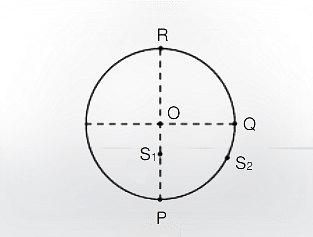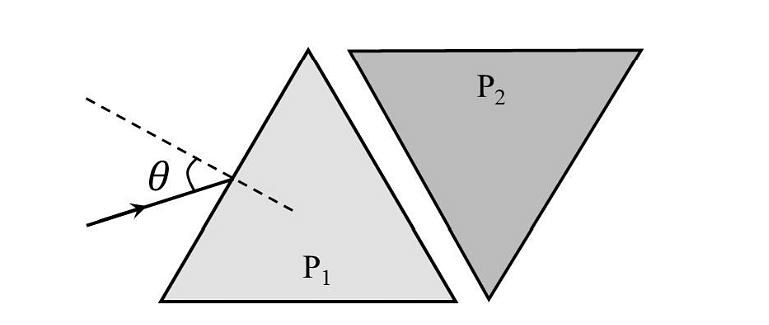Question:
Two loudspeakers $M$ and $N$ are located $20\, m$ apart and emit sound at frequencies $118 \,Hz$ and $121 \,Hz$, respectively. A car is initially at a point $P, 1800\, m$ away from the midpoint $Q$ of the line $MN$ and moves towards $Q$ constantly at $60\, km / hr$ along the perpendicular bisector of $MN$. It crosses $Q$ and eventually reaches a point $R , 1800\, m$ away from $Q$. Let $v( t )$ represent the beat frequency measured by a person sitting in the car at time $t$. Let $v_{ P }, v _{ Q }$ and $v _{ R }$ be the beat frequencies measured at location $P , Q$ and $R$, respectively. The speed of sound in air is $330\, ms ^{-1} .$ Which of the following statement(s) is(are) true regarding the sound heard by the person?
Two loudspeakers $M$ and $N$ are located $20\, m$ apart and emit sound at frequencies $118 \,Hz$ and $121 \,Hz$, respectively. A car is initially at a point $P, 1800\, m$ away from the midpoint $Q$ of the line $MN$ and moves towards $Q$ constantly at $60\, km / hr$ along the perpendicular bisector of $MN$. It crosses $Q$ and eventually reaches a point $R , 1800\, m$ away from $Q$. Let $v( t )$ represent the beat frequency measured by a person sitting in the car at time $t$. Let $v_{ P }, v _{ Q }$ and $v _{ R }$ be the beat frequencies measured at location $P , Q$ and $R$, respectively. The speed of sound in air is $330\, ms ^{-1} .$ Which of the following statement(s) is(are) true regarding the sound heard by the person?
Updated On: Jul 14, 2022

- The rate of change in beat frequency is maximum when the car passes through Q
- $V_P + V_R = 2V_Q$

Hide Solution
Verified By Collegedunia
The Correct Option is D
Solution and Explanation

Was this answer helpful?
0
0
Top Questions on doppler effect
- A source (S) of sound has frequency\( 240 Hz\). When the observer (O) and the source move towards each other at a speed \(v\) with respect to the ground (as shown in Case 1 in the figure), the observer measures the frequency of the sound to be \(288 Hz\). However, when the observer and the source move away from each other at the same speed v with respect to the ground (as shown in Case 2 in the figure), the observer measures the frequency of sound to be \(n\) Hz. The value of \(n\) is _____.

- JEE Advanced - 2024
- Physics
- doppler effect
- A train is moving with a speed of \(10 m/s\) towards a platform and blows a horn with frequency \(400 Hz\). Find the frequency heard by a passenger standing on the platform. Take speed of sound = \(310 m/s\).
- JEE Main - 2023
- Physics
- doppler effect
A source of sound is moving away from a stationary observer with constant velocity 40 m/s. Find frequency heard by observer, if original frequency of source is 400 Hz and speed of sound in air is 360 m/s
- JEE Main - 2023
- Physics
- doppler effect
- A car P travelling at 20 \(ms^{–1}\) sounds its horn at a frequency of 400 Hz. Another car Q is travelling being the first car in the same direction with a velocity 40 \(ms^{–1}\) . The frequency heard by the passenger of the car Q is approximately [Take, velocity of sound = 360 \(ms^{–1}\) ]
- JEE Main - 2023
- Physics
- doppler effect
- S1 & S2 are sources of the sound of frequency 656 Hz. S1 is moving along OP and S2 is moving on the circle in an anticlockwise direction with a constant speed of 4√2 m\s. P is a detector that is fixed. Select the correct options (Vsound=300m\s)

- JEE Advanced - 2023
- Physics
- doppler effect
View More Questions
Questions Asked in JEE Advanced exam
- Let \(S=\left\{\begin{pmatrix} 0 & 1 & c \\ 1 & a & d\\ 1 & b & e \end{pmatrix}:a,b,c,d,e\in\left\{0,1\right\}\ \text{and} |A|\in \left\{-1,1\right\}\right\}\), where |A| denotes the determinant of A. Then the number of elements in S is _______.
- JEE Advanced - 2024
- Matrices
- A block of mass \(5 kg\) moves along the \(x-\)direction subject to the force \(F = (−20x + 10) N,\) with the value of \(x \) in metre. At time \(t = 0 s,\) it is at rest at position \(x = 1 m\). The position and momentum of the block at \(t = (\pi/4)\) s are
- JEE Advanced - 2024
- Work-energy theorem
- Two equilateral-triangular prisms \(P_1 \)and \(P_2\) are kept with their sides parallel to each other, in vacuum, as shown in the figure. A light ray enters prism \(P_1\) at an angle of incidence 𝜃 such that the outgoing ray undergoes minimum deviation in prism \(P_2\). If the respective refractive indices of \(P_1\) and\( P_2\) are \(√ 3 /2\) and \(√3\), then \(\theta = sin{−1}[\sqrt \frac{ 3}{ 2} sin ( \frac{\pi}{B} )],\) where the value of \(\beta\) is ______.

- JEE Advanced - 2024
- Ray optics and optical instruments
- Let \(\overrightarrow{OP}=\frac{\alpha-1}{\alpha}\hat{i}+\hat{j}+\hat{k},\overrightarrow{OQ}=\hat{i}+\frac{\beta-1}{\beta}\hat{j}+\hat{k}\) and \(\overrightarrow{OR}=\hat{i}+\hat{j}+\frac{1}{2}\hat{k}\) be three vector where α, β ∈ R - {0} and 0 denotes the origin. If \((\overrightarrow{OP}\times\overrightarrow{OQ}).\overrightarrow{OR}=0\) and the point (α, β, 2) lies on the plane 3x + 3y - z + l = 0, then the value of l is _______.
- JEE Advanced - 2024
- Vector Algebra
- Let \(\vec{p}=2\hat{i}+\hat{j}+3\hat{k}\) and \(\vec{q}=\hat{i}-\hat{j}+\hat{k}\). If for some real numbers α, β and γ we have
\(15\hat{i}+10\hat{j}+6\hat{k}=α(2\vec{p}+\vec{q})+β(\vec{p}-2\vec{q})+γ(\vec{p}\times\vec{q})\),
then the value of γ is ________.- JEE Advanced - 2024
- Vector Algebra
View More Questions
Concepts Used:
Doppler Effect
The Doppler effect is a phenomenon caused by a moving wave source that causes an apparent upward shift in frequency for observers who are approaching the source and a visible downward change in frequency for observers who are retreating from the source. It's crucial to note that the impact isn't caused by a change in the source's frequency.

The Doppler effect may be seen in any wave type, including water waves, sound waves, and light waves. We are most familiar with the Doppler effect because of our encounters with sound waves



